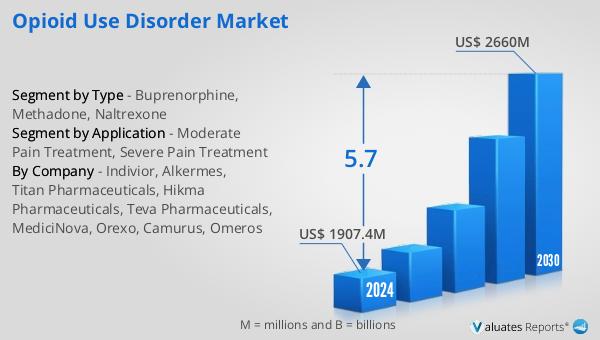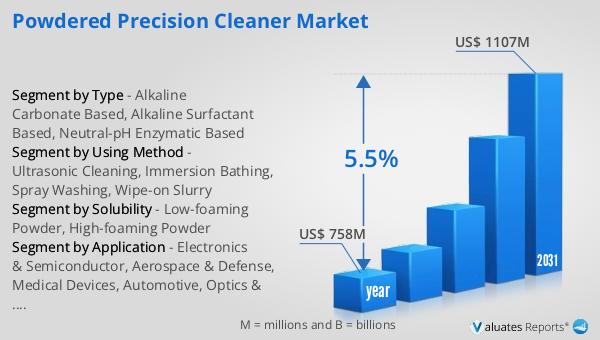What is Global Opioid Use Disorder Market?
The Global Opioid Use Disorder Market refers to the worldwide industry focused on addressing the challenges and treatment of opioid addiction. Opioid Use Disorder (OUD) is a medical condition characterized by the problematic use of opioid drugs, which include prescription pain relievers, heroin, and synthetic opioids such as fentanyl. The market encompasses a range of products and services aimed at treating and managing this disorder, including medications, therapies, and support systems. The increasing prevalence of opioid addiction, driven by factors such as over-prescription of painkillers and the availability of illicit opioids, has led to a growing demand for effective treatment solutions. This market is crucial as it not only addresses the health and well-being of individuals affected by OUD but also aims to reduce the societal and economic burdens associated with opioid addiction. The market's growth is fueled by advancements in medical research, increased awareness, and supportive government policies aimed at combating the opioid crisis. As the market evolves, it continues to focus on improving treatment outcomes, accessibility, and affordability for those in need.

Buprenorphine, Methadone, Naltrexone in the Global Opioid Use Disorder Market:
Buprenorphine, Methadone, and Naltrexone are three key medications used in the treatment of Opioid Use Disorder (OUD) within the global market. Buprenorphine is a partial opioid agonist, meaning it activates opioid receptors in the brain but to a much lesser degree than full agonists like heroin or methadone. This property makes it effective in reducing cravings and withdrawal symptoms without producing the same high, thus lowering the potential for misuse. Buprenorphine is often used in medication-assisted treatment (MAT) programs and is available in various forms, including tablets and films. Its use has been associated with improved treatment retention and reduced illicit opioid use, making it a cornerstone in OUD management. Methadone, on the other hand, is a full opioid agonist that has been used for decades in the treatment of OUD. It works by altering how the brain and nervous system respond to pain, thereby reducing withdrawal symptoms and cravings. Methadone is typically administered in a controlled clinical setting due to its potential for misuse and overdose. Despite these risks, it remains a highly effective treatment option, particularly for individuals with severe addiction. Methadone maintenance therapy has been shown to improve social functioning and reduce the risk of infectious diseases associated with opioid use. Naltrexone is an opioid antagonist, which means it blocks the effects of opioids at receptor sites in the brain. Unlike buprenorphine and methadone, naltrexone does not produce any opioid effects and is not addictive. It is available in oral and injectable forms, with the extended-release injectable form being particularly popular due to its once-monthly administration. Naltrexone is most effective for individuals who have already detoxified from opioids, as it requires complete abstinence before initiation. It works by preventing relapse and reducing cravings, thus supporting long-term recovery. The choice between these medications often depends on individual patient needs, treatment goals, and the healthcare setting. Each medication has its own set of benefits and challenges, and their use is often tailored to the specific circumstances of the patient. The global market for these medications is driven by the increasing recognition of OUD as a chronic medical condition that requires comprehensive treatment strategies. As research continues to advance, there is a growing emphasis on personalized medicine approaches that consider genetic, environmental, and lifestyle factors in treatment planning. This holistic approach aims to improve patient outcomes and enhance the overall effectiveness of OUD treatment.
Moderate Pain Treatment, Severe Pain Treatment in the Global Opioid Use Disorder Market:
The Global Opioid Use Disorder Market plays a significant role in the treatment of moderate to severe pain, which is often a precursor to opioid misuse and addiction. In the context of moderate pain treatment, opioids are typically prescribed when other pain management strategies, such as non-opioid medications or physical therapy, are insufficient. The market provides a range of opioid medications that are designed to effectively manage pain while minimizing the risk of addiction. These medications are often used in acute pain scenarios, such as post-surgical pain or injury-related pain, where short-term opioid use can be beneficial. However, the market also emphasizes the importance of careful prescribing practices and patient education to prevent the transition from legitimate medical use to misuse. For severe pain treatment, opioids remain one of the most effective options available. Conditions such as cancer-related pain, severe injury, or chronic pain syndromes often require the potent analgesic effects of opioids. The market offers a variety of formulations, including extended-release and immediate-release options, to cater to different pain management needs. In these cases, the focus is on balancing effective pain relief with the risk of developing OUD. The market supports the use of comprehensive pain management plans that incorporate both pharmacological and non-pharmacological approaches. This includes the use of opioids in conjunction with therapies such as cognitive-behavioral therapy, physical rehabilitation, and alternative medicine practices. The goal is to provide holistic care that addresses the physical, emotional, and psychological aspects of pain. The market also recognizes the importance of monitoring and follow-up in opioid prescribing. Regular assessment of pain levels, functionality, and potential signs of misuse are crucial components of responsible opioid use. The integration of technology, such as prescription monitoring programs and electronic health records, aids in tracking patient progress and ensuring safe prescribing practices. As the market continues to evolve, there is a growing emphasis on developing new pain management solutions that offer effective relief with a lower risk of addiction. This includes research into non-opioid analgesics, novel drug delivery systems, and personalized medicine approaches that tailor treatment to individual patient profiles. The ultimate aim is to provide effective pain management while minimizing the risk of OUD, thereby improving patient outcomes and quality of life.
Global Opioid Use Disorder Market Outlook:
The outlook for the Global Opioid Use Disorder Market indicates a significant growth trajectory, with projections showing an increase from $1,907.4 million in 2024 to $2,660 million by 2030. This growth is expected to occur at a Compound Annual Growth Rate (CAGR) of 5.7% during the forecast period. This expansion reflects the increasing demand for effective treatments and interventions for opioid addiction, driven by the ongoing opioid crisis and the need for comprehensive healthcare solutions. In comparison, the global pharmaceutical market was valued at $1,475 billion in 2022 and is anticipated to grow at a CAGR of 5% over the next six years. This indicates a robust growth pattern across the pharmaceutical sector, with the Opioid Use Disorder Market outpacing the overall market growth rate. Additionally, the chemical drug market, which was valued at $1,005 billion in 2018, is estimated to have increased to $1,094 billion by 2022. These figures highlight the dynamic nature of the pharmaceutical industry and the specific growth potential within the Opioid Use Disorder Market. The increasing awareness of opioid addiction as a public health issue, coupled with advancements in treatment options, is expected to drive further market expansion. As stakeholders continue to invest in research and development, the market is poised to offer innovative solutions that address the complex challenges of opioid addiction.
| Report Metric | Details |
| Report Name | Opioid Use Disorder Market |
| Accounted market size in 2024 | US$ 1907.4 million |
| Forecasted market size in 2030 | US$ 2660 million |
| CAGR | 5.7 |
| Base Year | 2024 |
| Forecasted years | 2025 - 2030 |
| Segment by Type |
|
| Segment by Application |
|
| By Region |
|
| By Company | Indivior, Alkermes, Titan Pharmaceuticals, Hikma Pharmaceuticals, Teva Pharmaceuticals, MediciNova, Orexo, Camurus, Omeros |
| Forecast units | USD million in value |
| Report coverage | Revenue and volume forecast, company share, competitive landscape, growth factors and trends |
